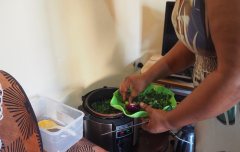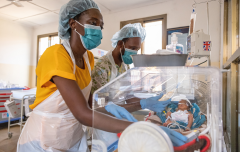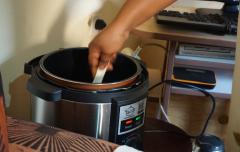Growing market potential of solar cold storage for horticulture products in Rwanda
Across human comfort and safety and medical and agricultural cold chains, small- to mid-size cooling businesses are working to generate technological solutions and take advantage of new business models. This story about sustainable cooling solutions in action was originally published in Chilling Prospects 2021.
Assess your specific access to cooling risk score and identify sustainable cooling solutions with the new Cooling for All Solutions Tool (beta).
A well-functioning food value chain is essential for sustainable nutrition. A food value chain combines the necessary and interlinked stages through which the food grown passes through a distribution cold chain before reaching the final consumer. In many developing countries, the lack of proper cold storage is a bottleneck that causes food losses due to biological degradation and jeopardizes profits for the farmers. Food losses due to lack of proper cold storage are particularly high in perishable products like fruits, vegetables and dairy.
While the most effective way to slow down the rate of spoilage is cooling, there is a deeper challenge in deploying cold storage in rural parts of developing countries: the lack of access to reliable electricity. In Rwanda for example, only 23 percent of the rural population had access to electricity in 2018 (World Bank Data 2021) which makes it difficult to deploy cold storage technologies for fruits, vegetables and other perishable goods that require reliable energy access.
In 2013 horticulture accounted for an estimated 3.2 percent of domestic GDP and 9.7 percent of agricultural GDP (Government of Rwanda 2014). Despite the importance of horticulture products in Rwanda’s agriculture economy, large quantities of crops are often lost. Tomatoes, for instance, are widely produced and consumed in Rwanda. The production reached 154,000 tonnes in 2014, compared to 135,000 tonnes in 2010. However, according to USAID (2018) it is estimated that 56 percent of the tomatoes produced in Rwanda are lost along the value chain, with the lack of cold storage being a major factor for this loss.
The market potential for solar cold storage
In areas where the electricity grid is unreliable, there are nevertheless decentralized technologies that are suited for areas that are not grid-connected. One such technology is solar cold storage. A recent assessment conducted by the FAO in Rwanda estimated the market potential of several solar energy technologies across all food value chains in Rwanda, including the market potential to deploy solar cold storage across the horticulture value chain. The assessment focused on the Government of Rwanda’s export target of 46,000 tonnes of horticulture products by 2024.
The results indicate that if the target is met, the market potential for solar cold storage could be as high as USD 6,105,000 with a 75 percent adoption rate of cold storage for horticulture products for export. The estimation, based on a new methodology developed by the FAO, aims to mobilize energy investments along food value chains in developing countries. The methodology first maps the food value chains to identify energy bottlenecks and then matches available energy technologies that can be deployed along the value chain to increase market output and efficiency and reduce food losses.
Credit: Manas Puri, Luis Rincon & Irini Matsoglou, UN FAO




